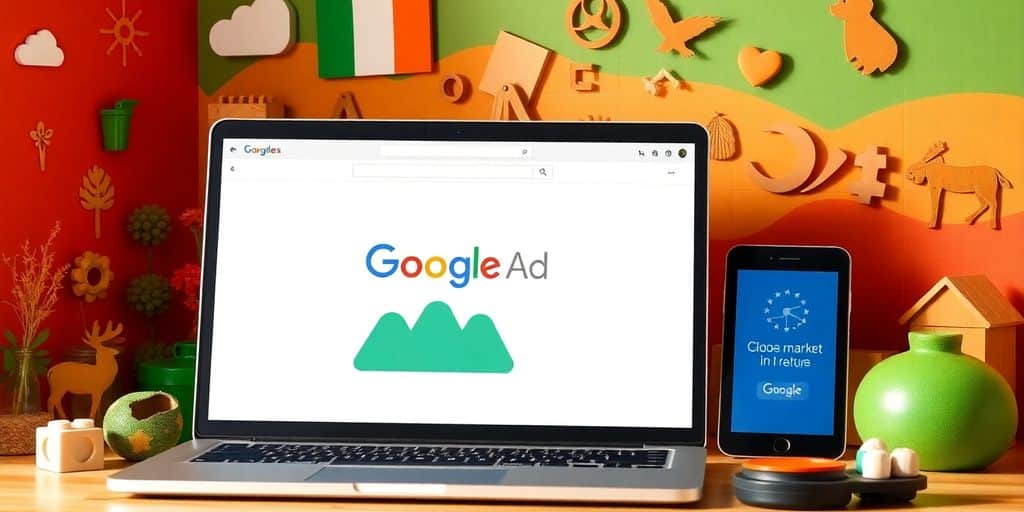So, you’ve decided to dive into the world of Google Ads in Ireland. It’s a bit like setting sail on a new adventure. You set up your campaign, watch the clicks roll in, and then… what? How do you know if it’s actually working? That’s where measuring success comes in. It’s not just about throwing money at ads and hoping for the best. You need to look at the numbers, tweak your strategies, and make sure you’re getting a bang for your buck. Let’s break it down, nice and simple, so you can really see how your ads are doing.
Key Takeaways
- Understanding the right metrics is crucial for measuring Google Ads success.
- Return on Investment (ROI) tells you if your spending is paying off.
- Ad performance analysis helps in making informed adjustments.
- Optimising ad spend can lead to more effective campaigns.
- Knowing your audience improves targeting and engagement.
Understanding Key Metrics for Google Ads Success

Importance of Click-Through Rate
When it comes to Google Ads metrics, the Click-Through Rate (CTR) is like the heartbeat of your campaign. It tells you how many folks saw your ad and thought, "Hey, that looks interesting!" and clicked on it. A higher CTR often means your ad is resonating well with the audience. But don’t get too carried away with just this number. A high CTR without conversions can be misleading. It’s crucial to look at this metric in conjunction with others to get the full picture.
- Influence on Ad Rank: A good CTR can positively affect your ad rank, helping your ad appear higher on the search results page.
- Cost Implications: Better CTR can lower your average cost per click, stretching your budget further.
- Ad Relevance: It often reflects how relevant your ad is to the audience.
Role of Conversion Rate
Conversion Rate is like the ultimate goal for your Google Ads campaign. It measures how many people took the desired action after clicking your ad, whether that’s buying a product, signing up for a newsletter, or filling out a contact form. This metric tells you if your ad is not just attracting clicks but also driving meaningful actions.
- Quality of Traffic: A high conversion rate indicates that your ad is attracting the right audience.
- Landing Page Effectiveness: Often, the conversion rate can highlight issues with your landing page if it’s not performing as expected.
- Optimisation Opportunities: By analysing this rate, you can tweak your campaigns for better results.
Evaluating Cost Per Click
Cost Per Click (CPC) is what you pay each time someone clicks on your ad. Keeping an eye on this is vital because it directly impacts your budget. The lower the CPC, the more clicks you can afford within your budget.
- Budget Management: Helps in determining how much you can spend on your ads.
- Bid Strategy: Understanding CPC can assist in setting your bid strategy to get the most out of your budget.
- Competitive Analysis: Comparing CPC with competitors can provide insights into your market position.
Understanding these key metrics can transform how you approach your Google Ads strategy. It’s not just about getting clicks; it’s about getting the right clicks that lead to conversions and manage costs effectively.
Evaluating Return on Investment in Google Ads
Calculating ROI for Campaigns
When it comes to Google Ads, understanding your return on investment (ROI) is like having a compass in the digital marketing wilderness. ROI is essentially the ratio of your net profit to your advertising costs. This figure tells you if your ad spend is translating into profits. To calculate ROI, you’ll need to know your total revenue from ads and subtract the cost of those ads. Then, divide this number by the ad costs and multiply by 100 to get a percentage. Here’s a simple formula:
- ROI (%) = [(Revenue – Cost) / Cost] x 100
This calculation helps you see if your Google Ads are paying off or just draining your budget.
Impact of ROI on Business Decisions
ROI isn’t just a number; it’s a decision-making tool. If your ROI is high, it means your ads are doing well, and you might want to invest more. On the flip side, a low ROI could mean it’s time to rethink your strategy. Businesses often use ROI to decide whether to continue, adjust, or stop a campaign. For example, if a campaign has a ROI of 150%, it means for every euro spent, you’re getting back 1.5 euros. That’s a green light to keep going or even scale up.
Strategies to Improve ROI
Improving ROI is about tweaking and testing. Start by analysing which keywords are performing best and allocate more budget there. Also, make sure your ad copy is engaging and relevant. Here are some strategies to consider:
- Optimise Keywords: Focus on high-performing keywords that bring in conversions.
- Refine Ad Copy: Ensure your ads are clear, compelling, and relevant to your audience.
- Enhance Landing Pages: Make sure the pages users land on are relevant and easy to navigate.
In the end, improving your ROI is a continuous process of testing and adjusting. It’s about finding what works and doing more of it, while cutting out what doesn’t.
For businesses in Ireland looking to boost their Google Ads ROI, working with experts like Sink or Swim Marketing can provide the tailored strategies needed to maximise returns.
Analysing Ad Performance for Better Results

Using Google Analytics Effectively
Google Analytics is a powerful tool for managing your Google Ads campaigns in Ireland. It provides insights into how users interact with your ads and website. By tracking metrics like bounce rate and session duration, you can gauge the effectiveness of your ads. Here are some steps to make the most of it:
- Set up goals to track conversions and other important actions.
- Use UTM parameters to track the performance of individual ads.
- Regularly check the Audience Overview to understand visitor demographics.
A well-configured Google Analytics account allows you to make data-driven decisions, ensuring your ad spend is as effective as possible.
Interpreting Ad Performance Reports
Performance reports are your best friend when it comes to understanding ad success. They provide a breakdown of key metrics like clicks, impressions, and conversions. Here’s what to focus on:
- Click-Through Rate (CTR): A high CTR indicates your ad is relevant to users.
- Conversion Rate: Shows how well your ad is turning clicks into actions.
- Cost Per Conversion: Helps you understand the cost-effectiveness of your campaigns.
Being able to interpret these metrics allows you to tweak your strategies for better results.
Adjusting Strategies Based on Data
Once you have the data, it’s time to act. Adjusting your strategy based on performance data can significantly improve your results. Consider these tactics:
- A/B testing different ad copies to see which performs better.
- Modifying your bidding strategy to focus on high-performing keywords.
- Pausing underperforming ads to reallocate budget to more successful ones.
Regular adjustments based on data can lead to more efficient campaigns, saving both time and resources.
Optimising Ad Spend for Maximum Efficiency
Understanding Return on Ad Spend
When it comes to Google Ads, understanding your Return on Ad Spend (ROAS) is key. It’s all about knowing how much revenue you’re getting for every dollar spent on advertising. Imagine spending €100 and earning €500 in return. That’s a ROAS of 5:1, which is pretty decent. Keeping track of this ratio helps you see if your campaigns are really paying off or if they need a bit of tweaking.
Balancing Budget and Performance
Finding the sweet spot between budget and performance can be tricky. You don’t want to blow all your cash on ads that don’t bring in results. Here are a few things to consider:
- Set clear goals: Know what you want from your campaigns.
- Monitor regularly: Keep an eye on how your ads are doing.
- Adjust as needed: Don’t be afraid to shift your budget around based on performance.
Techniques to Reduce Wasted Spend
Wasted spend is like throwing money into the wind. It happens when your ads are shown to the wrong people or at the wrong times. Here are some ways to cut down on waste:
- Use negative keywords: This stops your ads from showing up in irrelevant searches.
- Schedule your ads: Only run ads when your audience is most active.
- Geo-targeting: Focus on showing ads in locations where your audience is.
Tip: Regularly review your ad performance to spot areas where you might be overspending. Little tweaks here and there can make a big difference in your overall ad efficiency.
Enhancing Quality Score for Better Ad Placement

Factors Influencing Quality Score
Quality Score in Google Ads is a measure that reflects how relevant your ad is to the users seeing it. Three main factors influence this score: expected click-through rate (CTR), ad relevance, and landing page experience. Each of these elements plays a role in determining how well your ad performs in auctions. A high Quality Score is beneficial because it can lead to lower costs and better ad positions.
Improving Ad Relevance and Landing Pages
To boost your Quality Score, focus on making your ads more relevant to the keywords you are targeting. Use keyword-rich ad copy that aligns closely with the search terms your audience is likely to use. This involves crafting compelling ad content that clearly reflects the products or services you offer. Additionally, ensure your landing pages are directly related to your ads and provide a seamless user experience. A well-structured landing page that loads quickly and delivers what the ad promises can significantly improve user engagement.
Benefits of a High Quality Score
Achieving a high Quality Score offers several advantages. Firstly, it can reduce your cost per click (CPC), meaning you pay less for each interaction with your ad. Secondly, it often results in better ad positions, allowing your ads to appear more prominently in search results. Lastly, a high Quality Score can increase your ad’s visibility, leading to more clicks and potential conversions. In essence, focusing on Quality Score is not just about improving ad placement but also about making your campaigns more cost-effective.
Leveraging Audience Insights for Targeted Campaigns
Identifying Target Audience Segments
To make your Google Ads campaigns really hit the mark, you gotta know who you’re talking to. Start by breaking down your audience into segments. Think about their age, location, interests, and even their online behaviour. This way, your ads won’t just be floating around aimlessly. They’ll be right there, in front of the folks who are most likely to click and buy.
Utilising Demographic Data
Demographics are like the backbone of any good ad strategy. You can use data like age, gender, and income levels to tailor your messages. For instance, if you’re selling high-end tech gadgets, you might focus on a younger, tech-savvy crowd with a decent disposable income. Getting these details right can make your ads way more effective.
Customising Ads for Audience Engagement
Once you’ve got your audience sorted, it’s time to tweak those ads. Customisation is key. Use language and visuals that speak directly to your audience’s needs and wants. Whether it’s a catchy headline or a compelling call-to-action, make sure it resonates with them.
Tailoring your ads not only boosts engagement but also improves your return on investment. When your audience feels understood, they’re more likely to respond positively.
- Use language that matches the audience’s tone.
- Include visuals that appeal to their interests.
- Test different versions to see what works best.
By focusing on these aspects, you’ll not only reach the right people but also engage them effectively, turning clicks into conversions.
Monitoring Competitor Activity in Google Ads
Identifying Competitor Strategies
Keeping an eye on what your competitors are up to can be a game-changer for your own Google Ads campaigns. You want to know how they’re structuring their ads, what keywords they’re targeting, and how their ads are performing. Understanding these elements can give you a competitive edge. Start by identifying the key players in your market. Use tools that offer insights into competitor ad strategies, like competitor analysis services, which help businesses keep track of industry trends and refine their marketing strategies.
Analysing Competitor Ad Performance
Once you’ve got a list of competitors, dig into their ad performance. Look at their ad copy, design, and even the offers they present. Are they using video ads or sticking to text? Do they have seasonal promotions or year-round deals? Create a simple table to track these elements:
| Competitor | Ad Type | Keywords | Offers/Promotions |
|---|---|---|---|
| Competitor A | Text | Keyword 1, Keyword 2 | 10% off summer sale |
| Competitor B | Video | Keyword 3, Keyword 4 | Free shipping |
Adapting to Competitive Changes
The digital ad space is always shifting. What works today might not work tomorrow, so it’s crucial to stay flexible. If you notice a competitor shifting strategies, consider why. Have they changed their target audience or adjusted their messaging? Here are a few steps to adapt to these changes:
- Regularly review competitor ads and note any changes.
- Update your own keywords and ad copy to stay relevant.
- Experiment with new ad formats if competitors find success with them.
Staying informed about your competitors’ moves isn’t just about copying them; it’s about understanding the market landscape and making informed decisions to improve your own campaigns.
Keeping an eye on what your competitors are doing in Google Ads is really important. By watching their ads, you can learn what works and what doesn’t. This way, you can make your own ads better and stand out. If you want to know more about how to improve your Google Ads, visit our website for helpful tips and a free quote!
Conclusion
So, there you have it. Keeping tabs on your Google Ads campaign in Ireland isn’t just about watching numbers go up or down. It’s about understanding what those numbers mean for your business. Whether you’re looking at ROI, click-through rates, or conversion rates, each metric tells a part of the story. And remember, it’s not just about the data—it’s about what you do with it. Tweak your strategies, try new things, and don’t be afraid to make changes. After all, the digital world is always moving, and your ads should too. Happy advertising!
Frequently Asked Questions
What is the Click-Through Rate (CTR) in Google Ads?
The Click-Through Rate, or CTR, shows how often people who see your ad actually click on it. It’s a good way to see if your ad is catching people’s attention.
How do I calculate the Conversion Rate?
To find the Conversion Rate, divide the number of conversions (like sales or sign-ups) by the total number of visitors. Then, multiply by 100 to get a percentage.
What does Cost Per Click (CPC) mean?
Cost Per Click, or CPC, is how much you pay each time someone clicks on your ad. It’s important to keep track of this to make sure you’re not spending too much.
How can I measure the Return on Investment (ROI) for my ads?
You can measure ROI by comparing the profit you’ve made from your ads to how much you’ve spent on them. It’s a way to see if your ads are making money for your business.
What is a Quality Score in Google Ads?
Quality Score is a number that Google gives to show how good your ad is. It looks at things like how relevant your ad is to the keywords and how good your landing page is.
Why is it important to know my target audience?
Knowing your target audience helps you make ads that speak directly to the people who are most likely to be interested in your product or service. This can lead to better results.
















